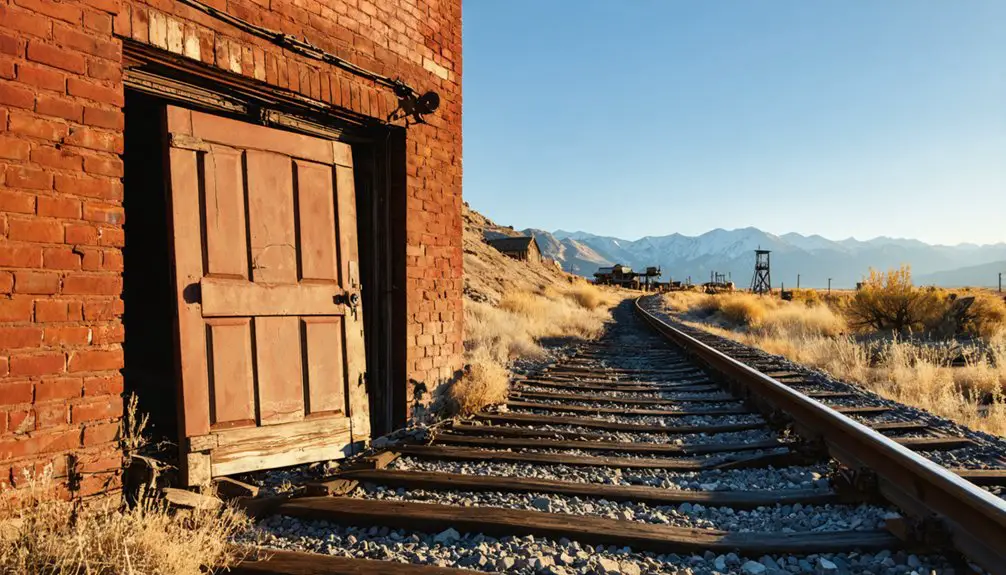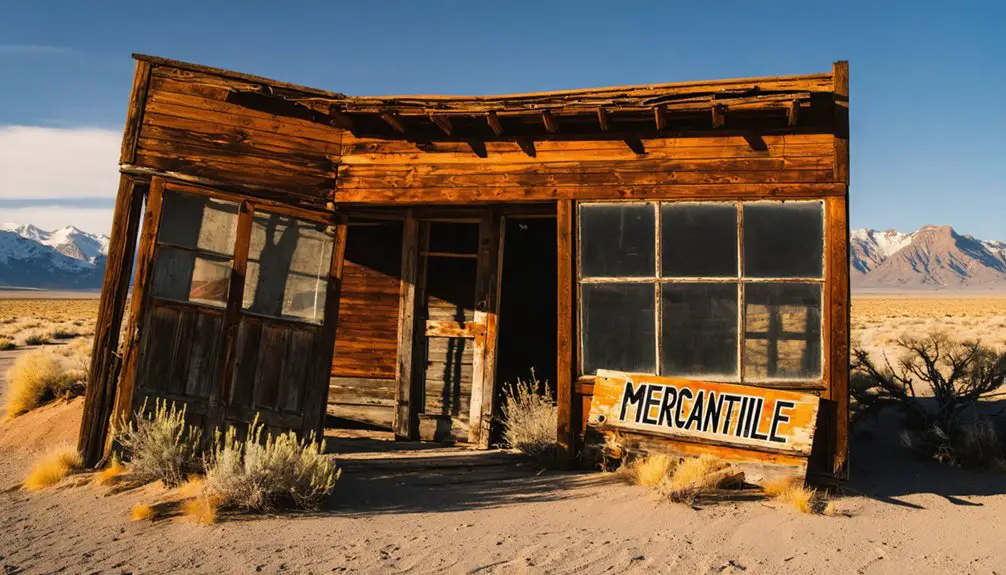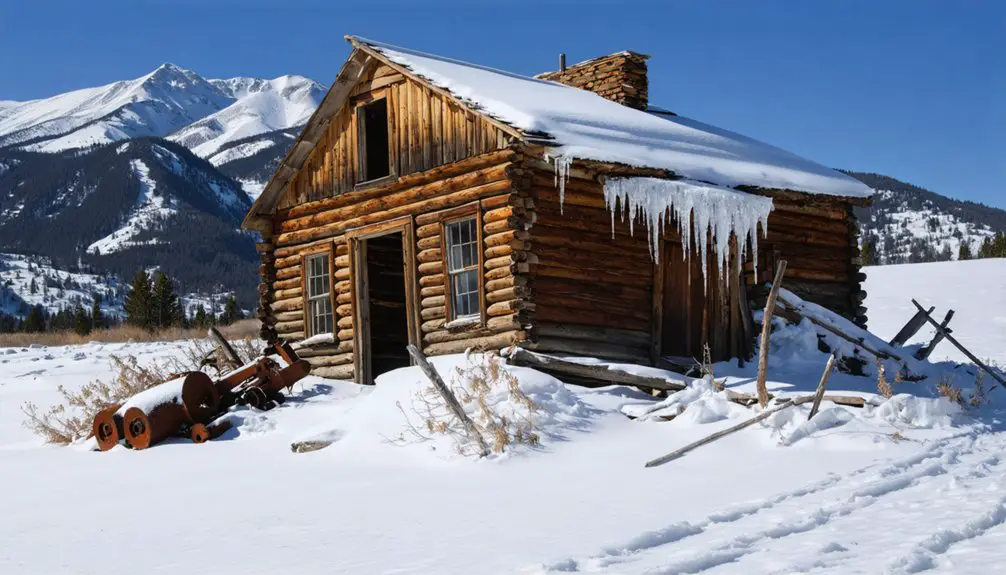You’ll find Utah’s ghost towns scattered across rugged valleys where prospectors once sought silver, copper, and gold fortunes in the 1800s. Places like Silver Reef, which produced 7 million ounces of silver, and Frisco, yielding $60 million before its mine collapsed, now stand as weathered remnants of the American West. From Grafton’s restored pioneer structures to Old Irontown’s beehive-shaped ovens, these abandoned settlements hold countless stories of boom, bust, and survival.
Key Takeaways
- Silver Reef offers guided living history tours during spring and fall, featuring the restored Wells Fargo Express Building museum with mining artifacts.
- Grafton’s restored pioneer structures include an 1868 adobe schoolhouse and cemetery, accessible for historic site exploration.
- Old Irontown showcases unique beehive-shaped charcoal ovens and foundry remains from Utah’s early iron production history.
- Thistle’s haunting partially submerged buildings can be viewed from U.S. Route 6/89, creating an otherworldly adventure landscape.
- Photography enthusiasts can capture ghost town ruins during golden hour, but should prepare with proper gear and safety equipment.
Uncovering Utah’s Forgotten Mining Legacy
Rugged mountains and mineral-rich valleys across Utah tell the story of countless mining towns that transformed the state’s landscape in the late 1800s.
You’ll discover the remains of once-bustling communities like Frisco and Silver City, where mining techniques extracted copper, gold, lead, silver, and zinc from the earth. These towns exploded with life as prospectors rushed to stake their claims, building hotels, saloons, and stores seemingly overnight.
The economic impacts were dramatic but fleeting. When Frisco’s population soared to 6,000 in 1885, it embodied the classic boom-and-bust cycle of the American West. Today, visitors can explore these sites as they serve as historical markers for tourism and educational opportunities.
After the Horn Silver Mine collapsed that same year, the town’s fate was sealed. Like many Utah mining settlements, it couldn’t survive when its primary economic engine failed, leaving behind silent ruins as evidence of its former glory. The mine’s total production reached an impressive $60 million in silver before operations ceased completely.
The Rise and Fall of Silver Reef
As you explore Silver Reef’s ruins today, you’ll find traces of a remarkable boomtown that grew from John Kemple’s 1866 discovery to house over 1,500 residents and 100 businesses along its mile-long Main Street by 1884.
The town’s unique claim to fame was its sandstone silver, setting it apart from any other mining operation in North America. You’re walking through what was once Washington County’s most prosperous non-Mormon settlement, complete with saloons, a Wells Fargo office, and even a horse racetrack that showcased the town’s vibrant social life. The local economy thrived on the 37 active mines that produced millions in silver ore.
The town’s swift decline came with falling silver prices and flooded mines, transforming this once-bustling community into a ghost town by 1891, with most of its buildings either abandoned or relocated to nearby Leeds.
Mining Boom and Prosperity
Despite initial skepticism about silver occurring in sandstone rather than typical veins, Silver Reef‘s mining boom began in earnest during 1875 when local prospectors confirmed rich deposits averaging 20-50 ounces per ton.
You’ll find that mining techniques were relatively straightforward, with shallow operations rarely exceeding 350 feet in depth, targeting lens-shaped ore bodies that stretched 200-300 feet. Men and mules worked tirelessly to extract the precious metal from the earth.
The economic impact was staggering. By 1879, you’d have seen a thriving town of 2,000 residents, with over 400 mine openings dotting the landscape.
The district’s crown jewel, Buckeye Reef, yielded nearly 70% of the area’s impressive 7 million ounces of silver production.
The bustling mile-long business district and bullion worth $250 million in today’s value proved Silver Reef’s remarkable prosperity.
The town’s decline was swift, and by 1901, most buildings were either torn down or moved, leaving behind only a handful of structures from the original settlement.
Ghost Town Legacy Today
Once Silver Reef’s mining boom ended in the 1880s, the town’s population plummeted from nearly 2,000 residents to just 177 by 1890.
By 1901, most buildings were either demolished or moved to nearby Leeds, leaving behind a haunting reminder of the American West’s boom-and-bust cycle.
Today, you’ll find Silver Reef among Utah’s best-preserved ghost towns, where ghost town preservation efforts have transformed the Wells Fargo Express Building into a fascinating museum. The bustling Main Street once featured nine grocery stores and numerous businesses during its heyday.
You can explore mining tools, historic photographs, and personal letters that tell stories of religious diversity and pioneer life. Visitors can join living history tours on weekends during spring and fall to experience the town’s past through costumed guides.
The original jail, with its double-thick walls, still stands as proof of the town’s cultural significance.
While most mining attempts failed after the boom, the site’s unique geology – featuring silver in sandstone and uranium – continues to intrigue scientists and history buffs alike.
Grafton: A Pioneer Dream Lost to Nature
You’ll find several restored pioneer structures still standing at Grafton, including the 1868 adobe schoolhouse that served as a church and community center.
While Mormon settlers established this Virgin River town in 1859 to grow cotton for Brigham Young’s self-sufficiency initiative, nature had other plans.
The Virgin River’s relentless floods repeatedly destroyed crops, filled irrigation ditches with silt, and eventually forced the last resident to abandon Grafton in 1944.
The Heritage Partnership Project maintains the historic buildings and cemetery to preserve this slice of pioneer life.
Today, descendants of original settlers gather for annual reunions to commemorate their pioneering ancestors and preserve the town’s legacy.
Historical Buildings Still Stand
While time has claimed many pioneer settlements across Utah, several remarkable buildings still stand in Grafton’s historic district, offering visitors a rare glimpse into 19th-century Mormon frontier life.
You’ll discover the schoolhouse-church from 1886, where pioneers gathered for education and worship, its handcrafted adobe walls showcasing historic architecture at its most authentic.
The Russell Home (1888) and Wood Home (1877) reveal pioneer resilience through their locally sourced materials and practical construction methods.
Don’t miss the Ballard Home from 1907, one of the last built before abandonment.
Each structure tells its own story, from the weathered outbuildings to the preserved barns, creating a complete picture of frontier life that’s made Grafton a treasured backdrop for Western films.
Nature’s Force Drove Settlers
Despite initial hopes of establishing a thriving settlement, Grafton’s pioneers faced relentless environmental forces that ultimately crushed their frontier dreams.
You’ll find evidence of settler resilience in their weekly battles against silt-clogged irrigation ditches and repeated flood damage on the Virgin River floodplain. These environmental challenges proved insurmountable – by 1890, only four families remained.
The town’s position on the river’s south bank left settlers isolated, while harsh winters and devastating floods repeatedly destroyed their crops and infrastructure.
Though they demonstrated remarkable adaptability, rebuilding after each disaster, nature’s persistent assault eventually won. By 1944, the last residents abandoned their homes, making Grafton distinct from typical ghost towns – it wasn’t depleted resources that drove people away, but rather nature’s unrelenting force.
Exploring Old Irontown’s Industrial Past
As you explore the remnants of Old Irontown’s industrial complex, you’ll discover a remarkable evidence of Mormon pioneer ingenuity from 1868. This symbol of industrial innovation produced up to seven tons of pig iron daily, supplying essential materials to regional railroads and Nevada mines.
While the settlement faced cultural challenges from the influx of non-Mormon workers, it remained a significant hub of production until economic pressures forced its closure in the 1870s.
- Distinctive beehive-shaped charcoal ovens still stand as silent sentinels
- The foundry’s chimney rises above weathered structural foundations
- Iron from here helped build the St. George Temple
- Peak production supported 19 families and nearly 100 residents
- You can access these historic ruins via State Route 56 from Cedar City
Thistle: The Town That Nature Reclaimed

Unlike most ghost towns that faded due to economic decline, Thistle, Utah met its dramatic end in 1983 when nature released America’s costliest landslide. Founded in 1883, this once-bustling railroad hub supported 600 residents at its peak, complete with stores, schools, and essential rail facilities.
You’ll find Thistle’s haunting remains in Spanish Fork Canyon, where the landslide impact created an artificial lake that submerged most structures. The town abandonment was swift and total after floodwaters lifted buildings from their foundations, leaving only a red schoolhouse and half-sunken homes as evidence of the disaster.
While many remnants burned in a 2018 wildfire, you can still view the site’s eerie landscape from U.S. Route 6/89. Remember to respect private property – observe from designated pullouts along the highway.
Ghost Town Photography Guide
Planning to photograph Utah’s ghost towns requires specialized equipment and techniques to capture their haunting beauty effectively. You’ll need a versatile camera with manual controls, multiple lenses, and a sturdy tripod to master ghost town photography in varying light conditions.
Mastering ghost town photography demands the right gear – a capable camera, quality glass, and solid support for haunting desert captures.
When composing your shots, focus on telling the story of abandonment through contrasting textures and nature’s reclamation of these historic structures.
- Pack extra batteries and memory cards – Utah’s remote locations offer no charging stations
- Shoot during golden hour to capture warm light on weathered wood and rusty metal
- Bring a flashlight for exploring dark interiors safely while respecting structural integrity
- Consider overcast days for even lighting across building facades
- Use leading lines from old railroad tracks or wooden walkways to draw viewers in
Planning Your Ghost Town Road Trip

While Utah’s ghost towns beckon adventurous travelers, successful exploration requires meticulous preparation and strategic route planning. Start by mapping out ghost town itineraries that combine sites like Elgin Station and Mercur, both about 60 miles from Salt Lake City.
You’ll want to research each location’s public access status and compile GPS coordinates, as cell service is often nonexistent.
When crafting planning essentials, factor in southern Utah’s ghost town clusters, like Sego, Cisco, and Thompson Springs, which you can explore efficiently in a single day.
Stock up on supplies, including water, fuel, and emergency gear, before venturing into remote areas. Base yourself in nearby towns unless you’re equipped for wilderness camping, and always inform others of your travel plans.
Schedule visits during ideal weather conditions and allow buffer days for unexpected discoveries.
Safety Tips for Ghost Town Explorers
Before setting foot in Utah’s historic ghost towns, you’ll need to prioritize personal safety amid the unique hazards of these remote desert locations.
When exploring dangers in these abandoned settlements, proper preparation can mean the difference between an incredible adventure and a dangerous emergency. Maneuvering through terrain requires careful attention to both natural and structural hazards.
- Always carry plenty of water and sun protection – Utah’s desert climate shows no mercy to unprepared explorers.
- Download detailed maps and bring backup navigation tools, as cell service is unreliable in remote areas.
- Pack emergency supplies including first aid kits, flashlights, and portable phone chargers.
- Stay out of abandoned mines and unstable structures, no matter how tempting they appear.
- Inform someone of your planned route and expected return time before heading out.
Preserving Utah’s Abandoned Heritage

Utah’s ghost towns represent more than just abandoned buildings – they’re treasured pieces of American Western heritage that deserve careful preservation.
You’ll find organizations like the Grafton Heritage Partnership working diligently to maintain these historic sites’ National Register status while protecting both structures and surrounding landscapes.
Through heritage preservation efforts, you can explore authentically restored adobe schoolhouses and Wells Fargo buildings that showcase original materials and construction techniques.
Step back in time through preserved adobe schoolhouses and Wells Fargo buildings, where pioneer craftsmanship lives on in every detail.
Community involvement plays an essential role, as local groups partner with state and federal agencies to protect these historic treasures.
You’re encouraged to participate in educational programs and digital documentation projects that help keep Utah’s pioneer history alive.
Frequently Asked Questions
Are There Any Reported Paranormal Activities in Utah’s Ghost Towns?
You’ll find haunted locations throughout Utah’s ghost towns, with ghostly sightings at Helper’s historic buildings, Ophir’s mining ruins, and Benson Grist Mill, where “Alice” reportedly haunts the grounds after drowning.
Can I Legally Take Artifacts Found in Ghost Towns?
No, you can’t legally take artifacts from ghost towns. Legal regulations strictly prohibit removal from public or tribal lands. Artifact ownership requires permits, and violations can result in hefty fines and imprisonment.
Which Ghost Towns Allow Camping or Overnight Stays?
Want true ghost town freedom camping? You’ll find informal overnight spots in Cisco and Thompson Springs, but there aren’t established camping amenities. Always check local overnight regulations and respect private property boundaries.
Do Any Ghost Towns Have Guided Tours Available?
You’ll find guided explorations throughout Utah’s ghost towns, from St. George’s walking tours to Zion’s Grafton excursions and Salt Lake City’s paranormal investigations, each highlighting the historical significance of these abandoned places.
Are There Entrance Fees to Visit Utah’s Ghost Towns?
Time’s your friend when visiting Utah’s ghost towns – you’ll find entrance fees vary widely. Some like Grafton are free with optional donations, while museum sites like Silver Reef charge nominal admission.
References
- https://www.ksl.com/article/51308628/restored-utah-ghost-towns-that-should-be-on-your-summer-travel-bucket-list
- https://www.deseret.com/utah/2024/06/03/how-to-visit-utah-ghost-towns/
- https://www.valleyjournals.com/2024/10/02/507818/exploring-utah-s-ghost-towns-seven-abandoned-settlements-with-fascinating-histories
- https://www.atlasobscura.com/things-to-do/utah/ghost-towns
- https://www.grandcountyutah.net/388/Ghost-Towns-Communities
- https://www.ksl.com/article/51362209/how-the-past-lingers-in-these-utah-ghost-towns
- https://www.familysearch.org/en/wiki/Utah_Ghost_Towns
- https://www.geotab.com/ghost-towns/
- https://www.youtube.com/watch?v=_Q_MurSaRyM
- https://en.wikipedia.org/wiki/Silver_Reef



